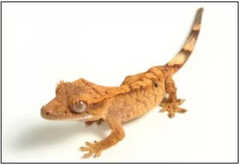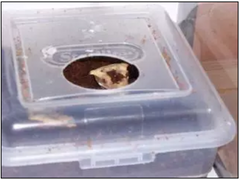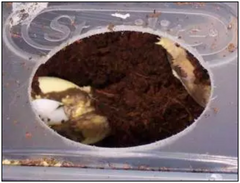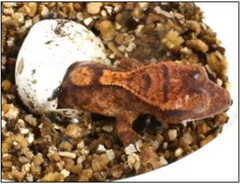Your Cart is Empty
Menu
-
- Live Animals
- Nutrition
- Habitats
- Habitat Supplies
- Light & Heat
- Humidity
- Husbandry
- Merch
-
- Contact Us
- Info
- Blog
- Professionals Login
- Gift Cards
- Login

Crested Gecko Care
May 13, 2019 11 min read
Crested Geckos, formerly known as Rhacodactylus ciliatus and recently re-classified as Correlophus ciliatus, are native to Southern Grand Terre, New Caledonia and at least one small surrounding island (Isle of Pines). Crested Geckos are semi-arboreal, spending most of their time in small trees and low shrubs. They will however, seek out hiding places near the ground to sleep during the day. Crested Geckos feed on both insects and fruits and in most cases can be kept at room temperature. The crested geckos ease of care, unusual appearance, and unlimited breeding potential, has contributed to their exploding popularity. There is no doubt that Crested Geckos are indeed one of the best pet lizards available today.
Crested Gecko Care Sheet
Housing and Habitats

Because Crested Geckos are so versatile and hardy, they can be kept in a number of different types of enclosures. Cresteds can be maintained in simple conditions or in elaborate naturalistic vivariums. Hatchlings to four month old crested geckos can be housed in an 8x8x12 glass terrarium or similar plastic enclosures. In some cases, young geckos housed in large cages will not eat well. To avoid that we recommend that geckos less than 12 weeks old be housed in cages no larger than a 8x8x12 glass terrarium. Four month old to adult crested geckos should be housed in a 12x12x18 terrarium or larger. An adult crested gecko can be comfortably housed in an 18x18x24 terrarium. Screen Cages have also been used with great success as long as an effort is made to keep the humidity up.
Keep in mind that regardless of what type of cage you use, that height is more desirable than length or width, particularly with adult geckos. There are now many glass and screen cages and terrariums that are designed specifically to house reptiles. These reptile specific terrariums have many advantages over aquariums designed for fish, and should definitely be considered even though the cost is a bit higher. The Exo Terra 12x12x18 terrarium is an ideal set up for a single sub-adult gecko. For an adult pair we recommend a minimum of The Exo Terra 18x18x24 terrarium.
Substrate
With so many reptile substrates to choose from, it is important to understand which options are safe for these geckos. In general, it is best to avoid substrates that can be potentially harmful if ingested in large quantities. Substrates that should be avoided include sand, wood chips, walnut husk, etc. One of the safest options would be paper towel to line the bottom of an enclosure. There is virtually no risk of a crested gecko ingesting paper towel and it can be quickly swapped out with a clean sheet, which makes cleaning quick and easy. For a more natural substrate, use Zoo Med Eco Earth. Eco Earth is a coconut fiber substrate that can help maintain humidity levels while resisting mold, mildew, and odors. Misting this substrate and allowing it to dry out by the next time you mist the enclosure helps to boost humidity levels for several hours. This substrate can be spot cleaned as needed and typically lasts several weeks before needing to be completely swapped out for fresh Eco Earth. Covering soil substrates with leaf litter and moss in live planted vivariums will reduce the risk of your gecko ingesting the substrate. This method is also beneficial for maintaining consistent moisture levels for vigorous plant growth and can help maintain a healthy colony of microfauna such as isopods and springtails.
Temperature, Heating, and Lighting
Temperatures for crested geckos should be maintained between 70 and 78 degrees for most of the year. At temperatures of 82 degrees or warmer, crested geckos will become stressed, which could lead to illness or death. Cresteds can tolerate nighttime temperature drops down into the mid 60's but it is not necessary to provide this type of nighttime drop. A two month cooling period is recommended to allow breeding crested geckos time to rest. During this period temperatures should be kept at 65 to 70 degrees.
A photoperiod of 12 to 14 hours of light is appropriate for most of the year, with ten hours of light being appropriate during the cooling period. Lighting is most easily achieved with the use of fluorescent lights placed directly on the cage top. This will facilitate both the requirements of the geckos and any live plants within the enclosure should you choose to have them. It is unnecessary to use UVB lighting for crested geckos. For large collections consider lighting the entire room with natural or artificial light. Crested Geckos may cease breeding and laying eggs if they are given less than 12 hours of light. In most situations, room temperature is adequate for crested geckos, as long as the temperature stays within 70 to 80 degrees. If you are attempting to breed your Crested Geckos, temps should be kept between 75 and 78 degrees. Use a good digital thermometer with a temperature probe to monitor the environment. If temps cannot be kept in this range, a small ceramic heat emitter can be suspended above the cage for 24-hour heat.
For more information on crested gecko heating, check out our new article Heating for Crested Geckos HERE
Humidity
Crested geckos do require moderate humidity. In most cases, this can be accomplished by misting the cage once or twice a day. A good hygrometer or thermometer/hygrometer combo meter is a valuable tool. Ideally, the humidity level should not drop below 50%. Crested geckos should get several hours of higher humidity (80-100%) every day to ensure that they shed properly. Misting heavily once or twice a day will achieve the required higher humidity levels. It is very important to allow the cage to dry to normal humidity levels in between mistings. If the cage is wet and humid all of the time, problems with shedding and bacterial infections can arise.
Diet and Feeding
Crested geckos can be fed a number of different ways. In this section, I will outline the different methods of feeding them in captivity.
1. CRESTED GECKO DIET ONLY: The easiest and most convenient method of feeding Crested Geckos is to use the powdered CRESTED GECKO DIET. These diets have been formulated to contain all of the essential fats, proteins, minerals, and vitamins that cresteds need. Crested geckos can be maintained on this diet alone however for optimum condition and health we recommend also feeding dusted and gut loaded insects once or twice per week.
 2. CRESTED GECKO DIET & INSECTS: Crested Geckos can be fed the Powdered Crested Gecko Foods along with crickets or other insects. Offer Pangea Fruit Mix Complete Diet3-4 times per week and insects 2-3 times per week.
2. CRESTED GECKO DIET & INSECTS: Crested Geckos can be fed the Powdered Crested Gecko Foods along with crickets or other insects. Offer Pangea Fruit Mix Complete Diet3-4 times per week and insects 2-3 times per week.
Feeding Insects: The best insects to feed are either crickets or feeder roaches, but crested geckos will sometimes consume waxworms or mealworms. There is some debate as to whether or not mealworms are safe to feed to crested geckos in that there is a possibility of them causing impaction, we choose not to feed them just to be on the safe side. The insects that you offer your geckos should be no larger than the distance from the gecko's nose to its eye. All feeder insects should be dusted with a good calcium and vitamin D3 powder such as PangeaCal. Insects should also be fed a high quality "gut load" diet for at least 24 hours prior to being offered to your geckos. Gut Loading enhances the nutritional value of the insects substantially.PIG Pangea Insect Grub is what we use. In addition to that, you can feed the insects dry fish flakes, leafy green vegetables, carrots, etc.
3. FRUIT MIXES, INSECTS, CUSTOM BLENDS: This method should only be used by advanced hobbyists who are able to gauge the health and wellbeing of their geckos. This method requires frequent checking of the calcium sacs, checking for weight loss, and other signs of deteriorating health. That being said, this is a viable method of feeding your geckos. For many years prior to the development of CRESTED GECKO DIET, hobbyists and breeders fed their geckos dusted crickets and supplemented fruit baby foods. The downside to this method is that there is a lot of guesswork in getting the right amounts of calcium, phosphorous, vitamins, and other essential nutrients. Too much or too little of these nutrients can be deadly, particularly with the fat soluble vitamins like Vitamin A, and Vitamin D3. I used to make my own diets using fruits, yogurt, bee pollen, spirulina, and other ingredients. Again if you are willing to keep a close eye on your geckos and willing to put some time and thought into your mixes, you can feed your own concoctions. Again this is not for the beginner or intermediate hobbyist; this requires a lot of research and time and can get to be quite expensive.
Water
Crested geckos typically drink water droplets from the sides of their enclosure and from any plants or cage accessories. This is one of the reasons it is important to mist your geckos daily. It is also recommended that a small dish of clean water is present in the enclosure at all times.
Checking the Calcium Sacs
Crested Geckos store calcium in the roof of the mouth in what are called endolymphatic sacs. You can check these reserves from time to time to monitor the storage level of calcium. This is particularly important for breeding female geckos and should be done periodically regardless of your feeding practices.

Handling Crested Geckos
Crested Geckos are among the most handleable of all lizards. They tolerate moderate to heavy handling even when they are relatively young, however, you should not handle geckos that are less than two weeks old or geckos that have recently been purchased or moved. There is a recommended one to two week acclimation period for newly acquired geckos which allows them to settle in and get used to their new surroundings. Once they are settled in, you can introduce your gecko to handling a little at a time. Five minutes of handling per day for the first few weeks is sufficient to allow your gecko to become used to you and to become less jumpy. Once they are comfortable with you, you can begin to handle them more. We recommend no more than 15 to 20 minutes of handling per day so as not to stress the gecko too much.
If your gecko is jumpy or flighty you can use what's called the "hand walking" method. To do this you simply hold one hand out directly in front of the gecko and allow him to hop, walk, or jump to the extended hand, then you immediately place your free hand out in front again, and so on. Young geckos and newly acquired geckos typically need to be hand walked for several sessions before you can expect them to calm down.
Tail Loss
Crested Geckos can drop their tails if handled improperly, however most cresteds are reluctant to drop their tails unless the tail is pinched or squeezed somehow. Most tail loss occurs from aggressive cage mates or from accidentally closing the tail in a screen top or door. Careful handling does not usually result in tail loss. Tail loss is a normal defense mechanism and is not a medical emergency. The gecko will recover quickly and does not require any special care. Crested geckos are one of the few geckos that will not regenerate a new tail.
Baby Crested Gecko Care

So you're wondering how to care for baby crested geckos. Baby crested geckos are cared for the same way as adults with a few exceptions. Babies should be misted twice a day, and should not be overhandled. Always allow newly acquired baby crested geckos time to acclimate to their new cage before you begin a handling routine. The acclimation period is usually one to two weeks. Care should be taken to make sure hatchling geckos shed properly. Some baby crested geckos will do better if housed in a smaller sized terrarium. A medium or large Herp Haven Kritter Keeper is perfect.
Breeding Crested Geckos
There are many different formulas people use for breeding and hatching crested geckos. Below we have detailed the process we have used successfully for several years.

Breeding crested geckos is as simple as having at least one healthy adult pair together. Males can usually start breeding at 9 months to a year old and females can breed as early as a year old. I highly recommend waiting a solid 14 months before breeding females. Females should be at the very least 35 grams before breeding assuming that they have their tail. Waiting until the female is 40 grams will result in a much more successful first breeding season, for that reason I highly recommend having patience and waiting to introduce the female at 40 grams. Subtract 3-5 grams for tailless females.
Breeding groups can consist of one male and up to four or maybe five females. Males kept together will sometimes fight violently, especially in the presence of a female. In order to induce breeding, temperatures should be kept between 75 and 79 during the day and can drop up to 5 degrees at night. The enclosure should be misted lightly once or twice a day particularly in the evening, however, you should not soak the cage so much that it doesn't dry up in a few hours.
Special attention should be paid to making sure the breeding crested geckos are getting plenty of high quality food. Gut loaded insects and the Pangea Fruit Mix Complete Diet are recommended. Make sure to dust the crickets with a good Calcium and Vitamin D3 powder. Check the calcium sacs of your breeding females (located on the roof of the mouth) once per month to make sure they are not getting depleted. If calcium sacs are small or non-existent you should separate the female from the male and start adding a pinch of calcium without vitamin d3 to her food each feeding.

An egg laying container should be used inside the cage for the females to dig in and lay their eggs. The container should be large enough to accommodate the female and allow her to dig down at least 3-4 inches. It is recommended that the egg laying medium be a 50-50 mix of moistened Peat Moss and Vermiculite. However straight Peat Moss works too. A piece of cork bark works well to conceal the container and make the female comfortable laying her eggs. You should check for eggs every morning while they are breeding and remove the eggs promptly so they do not dry up. Females will lay a new clutch of eggs every 25-35 days. The eggs should be placed in an airtight container with 2 inches of slightly moistened (3 parts water to 4 parts substrate-by weight) vermiculite, perlite, or a mixture of the two. A less scientific method is to wet the substrate thoroughly and then squeeze the excess water out which leaves you with a nice moist substrate but one that is not soaking wet. We use and recommend the Organic Vermiculite and have hatched over 10,000 eggs using it. You can poke a couple of small holes in your incubation container or you can open the lid once or twice a week for ventilation.

I keep the eggs at a constant 72 degrees and they hatch in about 65-90 days. Eggs have been hatched at a variety of temperatures ranging from 69 to 80 degrees. I would recommend incubating somewhere in between. Temperature dependent sex determination (whereby the sex of the offspring is determined by the temperature at which they are incubated) has not yet been proven with crested geckos.
If you have a pair or group that is not breeding you should take a look at the key factors such as temperatures, nutrition, cage space, age of the animals, etc.
Sex Determination
Determining the sex of crested geckos is easiest on geckos that are over 6 months old. Male crested geckos will develop a very noticeable hemipenal bulge just below the vent. The hemipenal bulge develops on males at between 5 months and 9 months old. Females do not develop a bulge. The photos to the right show the difference between mature males and females. Sexing subadult crested geckos is considerably more difficult. Using a 10x or better jewelers loupe or magnifying glass, you can look for evidence of pore development in the region just anterior to the vent. Pore development may be seen on males at 5-10 grams but sometimes the pores do not develop until later.
MALE 
FEMALE 
